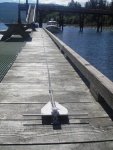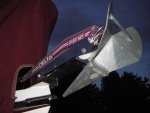thataway
Well-known member
- Joined
- Nov 2, 2003
- Messages
- 21,692
- Reaction score
- 63
- C Dory Year
- 2007
- C Dory Model
- 25 Cruiser
- Hull Identification Number
- DOR25652A707
- Vessel Name
- thataway
Amanda,
Go to Amazon and buy Chapman's Piloting and Seamanship. It is full of wisdom--and if you can make it all of the way thru it, you will have a store house of knowledge.
See my post about the depth sounder thread. We can walk you thru the installation.
Until you have the depth sounder, you should mark your anchor line. I just use electrical ties, and put one thru the line at specific distances. You can buy bundles which have different color ties, or put one tie at 25 feet, second tie at 50 feet etc--and then space them differently. That way you can guess the depth when you drop the anchor. It was not that long ago that some of us were boating before there were no depth sounders available--and we used "lead lines" This was a weight on the bottom of a thin line, which had markings every 6 feet (or fathom). We would count the knots in the line as it paid out to the bottom and could tell in the dark how deep (approximately) the bottom was. You can use you anchor rode as a sort of sounding line. Wow--you were lucky that no wind came up etc. You need a lot of line anchoring in deep water. Powell is nice, because there are some places with sloping shores. But some have deep drop offs, so you need a depth sounder there. The type of bottom is important--you don't want to get your anchor caught in a boulder and loose it.
Go to Amazon and buy Chapman's Piloting and Seamanship. It is full of wisdom--and if you can make it all of the way thru it, you will have a store house of knowledge.
See my post about the depth sounder thread. We can walk you thru the installation.
Until you have the depth sounder, you should mark your anchor line. I just use electrical ties, and put one thru the line at specific distances. You can buy bundles which have different color ties, or put one tie at 25 feet, second tie at 50 feet etc--and then space them differently. That way you can guess the depth when you drop the anchor. It was not that long ago that some of us were boating before there were no depth sounders available--and we used "lead lines" This was a weight on the bottom of a thin line, which had markings every 6 feet (or fathom). We would count the knots in the line as it paid out to the bottom and could tell in the dark how deep (approximately) the bottom was. You can use you anchor rode as a sort of sounding line. Wow--you were lucky that no wind came up etc. You need a lot of line anchoring in deep water. Powell is nice, because there are some places with sloping shores. But some have deep drop offs, so you need a depth sounder there. The type of bottom is important--you don't want to get your anchor caught in a boulder and loose it.



